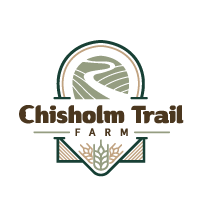
FAQs
We have put together for you common questions that we receive in regard to our products and how we farm. Please reach out to us if you have a question or concern that is not answered here for you at chisholmtrailfarm@gmail.com
Collapsible content
What are Wheatberries?
Wheatberries are the whole kernel of grain, consisting of the bran, germ, and endosperm.
What Do I Use Wheatberries For?
Wheatberries are very versatile!
First, you may mill them for fresh flour! Now, we realize not everyone has a countertop mill or wants to invest in one. You do have other options such as an attachment for your mixer, high powered blender, food processer, and we have even used a coffee grinder. Some of these won't get your flour as fine as a stone mill will but it gets you ground fresh flour to try and use!
Second, you may use wheatberries multiple ways. You may use on salads, in soups and stews, breakfast bowls, use as a side dish, stuff vegetables with, make pilaf, burgers and patties, casseroles, baked goods, and granola.
Are We Organic?
We are not organic. We do not wish to be certified in the way we farm. We want you to know that we grow our crops collaborating with Mother Nature. We like to leave our trash on top in the fall so that the soil has nutrients to feast on throughout the winter. We also like to plant cover crops to leave a living root in the ground to provide proper nutrients for the soil. We try out best to not till but if we have to we do it with a harrow so we disturb very little of the soil. We want to make sure that we do not destroy the microbiomes environment because they are essential to the health of our soil. There are more living organism in a teaspoon soil than there are people on the planet.
Why Do We Plant Cover Crops?
We use cover crops for multiple reasons:
- Soil Health Improvement: Cover crops help improve soil structure and health by preventing erosion, increasing organic matter, and enhancing soil fertility. They add biomass to the soil, which improves its physical and biological properties.
- Weed Suppression: Cover crops compete with weeds for sunlight, water, and nutrients, effectively reducing weed growth and minimizing the need for herbicides.
- Nutrient Management: Certain cover crops, such as legumes, can fix nitrogen from the air and add it to the soil, reducing the need for synthetic fertilizers. This helps in maintaining a nutrient balance in the soil.
- Moisture Retention: Cover crops help retain soil moisture by reducing evaporation and improving water infiltration. This is especially beneficial during dry periods.
- Pest and Disease Control: Cover crops can interrupt pest and disease cycles by providing habitat for beneficial insects and microorganisms that control pests and diseases naturally.
- Biodiversity Enhancement: By incorporating a variety of cover crops, we can enhance biodiversity, creating a more resilient and balanced ecosystem.
- Carbon Sequestration: Cover crops capture and store carbon in the soil, contributing to climate change mitigation efforts by reducing the overall carbon footprint of the farm.
Using cover crops is a sustainable farming practice that aligns with the farm's goals of maintaining healthy soil, reducing chemical inputs, and promoting environmental stewardship.
